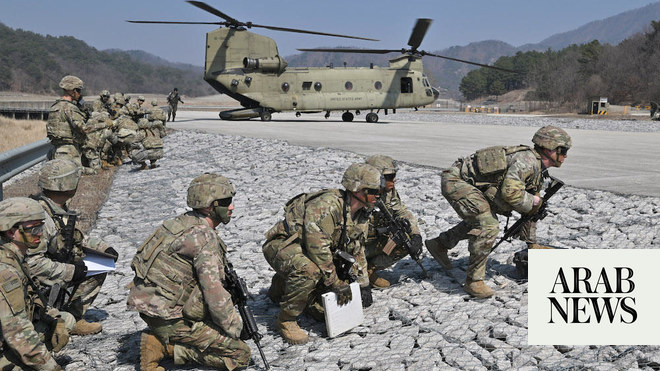
SEOUL: The US and South Korea announced Tuesday that their annual joint military drills would go ahead next month, with no significant downsize in scale despite an ongoing diplomatic thaw with North Korea.
The large-scale exercises involving tens of thousands of ground troops are a perennial source of tension between the two Koreas, with Pyongyang condemning them as provocative rehearsals for an invasion of the North.
With talks under way to set up a North-South summit, followed by a proposed face-to-face meet between Donald Trump and Kim Jong Un, there was speculation that this year’s drills might be scaled back to avoid derailing the discussions.
They had already been delayed to avoid clashing with the Pyeongchang Winter Games in the South last month.
But Washington and Seoul said the exercises, expected to resume on April 1, would be “similar” in size to those of previous years.
“The UN Command has notified today the North Korean military on the schedule as well as the defensive nature of the annual exercises,” Seoul’s defense ministry spokeswoman told reporters.
The Pentagon added in a statement: “Our combined exercises are defense-oriented and there is no reason for North Korea to view them as a provocation.”
According to a senior South Korean envoy who made a rare visit to Pyongyang earlier this month, Kim had made it clear he “understands” the need for the drills to go ahead.
Such an acknowledgement is in stark contrast to the Kim regime’s denunciations of the exercises in the past. The North has often responded to the drills with its own military actions, and last year fired four ballistic missiles close to Japan.
“Foal Eagle” is a series of field training exercises with approximately 11,500 US forces taking part, together with 290,000 South Korean troops, while “Key Resolve” is a command post exercise using mainly computer-based simulations.
The US, as South Korea’s security guarantor, has close to 30,000 troops stationed in the South — a legacy of the 1950-53 Korean War that ended with an armistice instead of a peace treaty.
Following an extended period of escalating tensions on the Korean peninsula, the Winter Olympics provided the catalyst for a sudden and very rapid rapprochement that resulted in the announcements of the planned summits.
Those announcements were made by the South Koreans, who have been orchestrating the diplomatic preparations and acting as the messenger between Washington and Pyongyang.
Trump’s administration is pushing ahead with plans for a summit before the end of May, but North Korea has yet to independently confirm it even extended an invitation to leadership talks — maintaining a silence that has raised some concerns in Washington and Seoul.
According to the South Korean envoy who met with Kim in Pyongyang, the North Korean leader also offered to consider abandoning his nuclear weapons in exchange for US security guarantees and flagged a halt to all missile and nuclear tests while dialogue was under way.
Kim Byung-yeon, an expert in North Korea’s economy at Seoul National University, said the ever-growing layer of sanctions on the North was pushing its regime to negotiations.
“With the economic damages caused by the sanctions growing ... the North seems to have come forward for talks to curb potential frustration among its people,” he said.
“I think the North will show more sincerity in upcoming negotiations than before,” he said.
The North-South summit — to be held at the border truce village of Panmunjom next month — will be the third summit between the two neighbors who remain technically at war.
The summit, if realized, will be an opportunity to test Kim’s willingness for nuclear disarmament demanded by the US, said Cheong Seong-chang, analyst at Sejong Institute think tank.
“It will be the first opportunity for the international community to gauge Kim’s intention and stance on the nuclear and missile arsenal before the Trump-Kim summit,” Cheong said.












